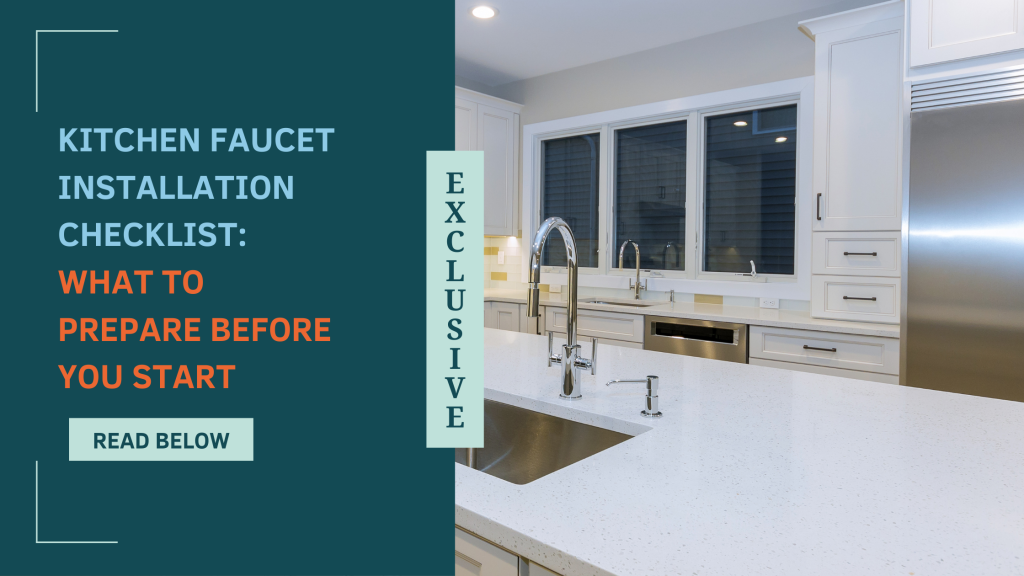Installing a kitchen faucet can be a rewarding home improvement project that upgrades your kitchen’s functionality and aesthetic. Whether you’re replacing an old sink faucet or installing a brand-new one, being prepared is key to ensuring a smooth and successful installation. In this checklist, we’ll guide you through everything you need to know—from the tools and equipment to the final testing process.
Tools and Equipment You’ll Need
Before you dive into the installation process, it’s essential to gather the necessary tools and equipment. Having everything on hand will make the task faster and less stressful.
Basic Tools for Faucet Installation
To install your kitchen water faucet properly, you’ll need a few basic tools:
- Wrenches: A basin wrench or adjustable wrench will help you tighten or loosen nuts in hard-to-reach spaces.
- Plumbers tape: For sealing threaded connections to prevent leaks.
- Screwdriver: A standard or Phillips-head screwdriver will come in handy for securing the faucet to the sink.
- Channel lock pliers: Useful for gripping and twisting pipes, nuts, or bolts that are difficult to maneuver.
- Bucket and towel: You’ll need these to catch any residual water and clean up spills.
Plumbing Supplies
Certain plumbing supplies will be necessary for a secure and leak-free installation:
- Faucet mounting hardware: Most kitchen faucet sets come with the required mounting hardware. Ensure you check this before purchasing.
- Flexible water supply lines: These are important for connecting the faucet to your water supply.
- Faucet washers and gaskets: Ensure a proper seal to avoid leaks.
Safety Equipment
Safety should always be a priority. Here are a few items to keep in mind:
- Gloves: Protect your hands from sharp edges, especially if you’re dealing with old plumbing or a short kitchen faucet.
- Safety glasses: These will help protect your eyes from debris and water during the installation.
Preparing the Installation Area
A little preparation goes a long way when it comes to faucet installation. Make sure your workspace is clean, organized, and ready to go.
Shut Off Water Supply
Before starting, it’s essential to shut off the water supply to avoid any surprises or flooding during installation. Typically, the water shutoff valves are located under the sink. Turn them clockwise to shut off the water flow. Test that the water is off by turning on the old faucet kitchen faucets.
Clear the Work Area
Clear out any items from under the sink to give yourself plenty of room to work. Make sure that you have enough space to maneuver the tools and faucet components comfortably. If you’re installing a faucet for double kitchen sink, clear both sides of the sink for ease of access.
Inspect Existing Plumbing
Before installing the new faucet, take a moment to inspect the existing plumbing. Look for any signs of leaks or corrosion around the pipes, valves, or existing kitchen sink faucets. If any plumbing issues are identified, it’s best to address them before proceeding with the faucet installation.
Faucet Compatibility and Sizing
Choosing the right faucet for your kitchen sink is critical. The wrong size or incompatible faucet could lead to difficult installation and potential leaks.
Choosing the Right Faucet
When selecting the best kitchen faucet, consider the following factors:
- Size and Design: If you have a small kitchen sink faucet, choose a short kitchen faucet that fits the limited space. For larger sinks, you may want a best pull down kitchen faucet for better reach.
- Single vs. Dual Handle: Decide between a best single handle kitchen faucet or a traditional dual-handle option. The best pull-down kitchen faucet offers more flexibility in terms of reach and versatility.
- Faucet Type: Consider whether a top kitchen faucet with a high-arc design or a best quality kitchen faucet with an integrated sprayer will suit your needs better.
Ensuring Proper Fit
Check that the kitchen faucet set you’re purchasing is the right size for your sink. Measure the number of mounting holes in your sink to make sure the faucet you choose will fit. If you’re unsure, check the specifications of the best rated kitchen faucets or consult with a professional.
Preparing the Plumbing Connections
After choosing the right faucet, it’s time to prepare the plumbing connections.
Check Water Supply Lines
Inspect the water supply lines for any signs of wear or damage. If you’re replacing an old kitchen faucet, consider replacing the supply lines as well, as they may be brittle or corroded. Using flexible supply lines is recommended for easier installation and flexibility in positioning the faucet.
Make sure the connections are tight but not overly tight to avoid damaging the threads. Use plumber’s tape on threaded connections to ensure a tight seal.
Inspect the Drainage System
Before installation, it’s important to check the drainage system under the sink. Inspect the drain pipes for any leaks or blockages, and make sure they are securely connected. If your faucet installation requires new drainage connections,Now is the time to address that as well.
Testing and Troubleshooting
Once you’ve completed the installation, it’s time to test the faucet and ensure everything is working as expected.
Pre-Installation Testing
Before securing the faucet fully in place, run a quick test to check the functionality of the kitchen water faucet. Turn on the water supply and check that the faucet handles work smoothly. Run the water for a minute to ensure there are no leaks at the base or around the water supply lines.
If you’re installing a faucet for double kitchen sink or best sink faucet, make sure both water lines are functioning correctly and there’s no cross-contamination between hot and cold water supplies.
Inspect for Leaks After Installation
After securing your faucet and ensuring that it’s properly mounted, it’s crucial to check for leaks. Turn on both the hot and cold water supplies, and inspect the faucet connections and water supply lines for any drips or puddles.
If any leaks are detected, shut off the water supply and recheck the connections. Tighten the connections gently and use additional plumber’s tape if necessary. If the problem persists, you may need to replace the washers or gaskets.
Conclusion
Proper kitchen faucet installation can make a world of difference in both the functionality and appearance of your kitchen. By following this checklist and ensuring you have the right tools, faucet compatibility, and plumbing connections, you’ll be able to complete the installation process efficiently and without any hitches. Whether you’re installing the best kitchen faucet from top faucet brands or opting for a sleek best pull-down kitchen faucet, your newly installed faucet will provide you with years of reliable service.
Remember, if you’re unsure about the installation process or encounter complications, it’s always a good idea to consult with a professional plumber to ensure everything is set up safely and properly.



